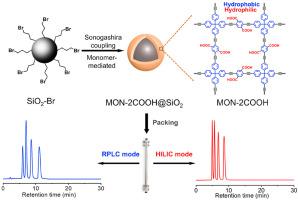Talanta ( IF 5.6 ) Pub Date : 2022-07-31 , DOI: 10.1016/j.talanta.2022.123763 Hao-Fei Sun 1 , Yuan-Yuan Cui 2 , Chang-Qing Zhen 3 , Cheng-Xiong Yang 2

|
Microporous organic networks (MONs) are promising in high performance liquid chromatography (HPLC) with large specific surface area, good hydrophobicity and stability. However, their superhydrophobic structures restrict MONs-based HPLC only in reversed-phase mode. To decrease the hydrophobicity of pristine MONs and to expand their broad application in HPLC, here we described the monomer-mediated fabrication of core-shell MON-2COOH@SiO2 microspheres for reversed-phase liquid chromatography (RPLC)/hydrophilic interaction liquid chromatography (HILIC) mixed-mode chromatography for the first time. The –COOH groups were introduced into MONs’ skeleton to improve their hydrophilicity and to provide hydrophilic interaction sites. The MON-2COOH was grafted onto silica via a monomer mediated method to produce monodispersed core-shell microspheres. By adjusting the concentration of reactants, the thickness of MON-2COOH shell was easily manipulated. The packed MON-2COOH@SiO2 column showed high resolution and selectivity for separating both hydrophobic (alkylbenzenes, polycyclic aromatic hydrocarbons, anilines and phenols) and hydrophilic (nucleoside and nucleic bases) probes, highlighting the promise of MONs in mixed-mode HPLC. The MON-2COOH@SiO2 column also achieved good separation to sulfonamides, nonsteroidal anti-inflammatory drugs, flavonoids and phenylurea herbicides, and offered better resolution than commercial C18 and pristine SiO2 column. Multiple retention mechanisms were also found on MON-2COOH@SiO2 packed column, underlining the great potential of MONs in mixed-mode HPLC.
中文翻译:

用于反相/亲水相互作用混合模式色谱的微孔有机网络@二氧化硅微球的单体介导制备
微孔有机网络(MONs)在高效液相色谱(HPLC)中具有大的比表面积、良好的疏水性和稳定性等优点。然而,它们的超疏水结构仅在反相模式下限制了基于 MONs 的 HPLC。为了降低原始 MON 的疏水性并扩大其在 HPLC 中的广泛应用,我们在此描述了单体介导的核壳 MON-2COOH@SiO 2的制备首次用于反相液相色谱(RPLC)/亲水相互作用液相色谱(HILIC)混合模式色谱的微球。将–COOH 基团引入MON 的骨架以提高其亲水性并提供亲水相互作用位点。通过单体介导的方法将 MON-2COOH 接枝到二氧化硅上,生产出单分散的核壳微球。通过调节反应物的浓度,可以很容易地控制 MON-2COOH 壳的厚度。填充的 MON-2COOH@SiO 2色谱柱在分离疏水性(烷基苯、多环芳烃、苯胺和苯酚)和亲水性(核苷和核碱基)探针时表现出高分辨率和选择性,突出了 MON 在混合模式 HPLC 中的前景。MON-2COOH@SiO2色谱柱还对磺胺类、非甾体类抗炎药、黄酮类和苯脲类除草剂实现了良好的分离,并提供比商业 C18 和原始 SiO 2色谱柱更好的分离度。在 MON-2COOH@SiO 2填充柱上也发现了多种保留机制,突显了 MON 在混合模式 HPLC 中的巨大潜力。











































 京公网安备 11010802027423号
京公网安备 11010802027423号